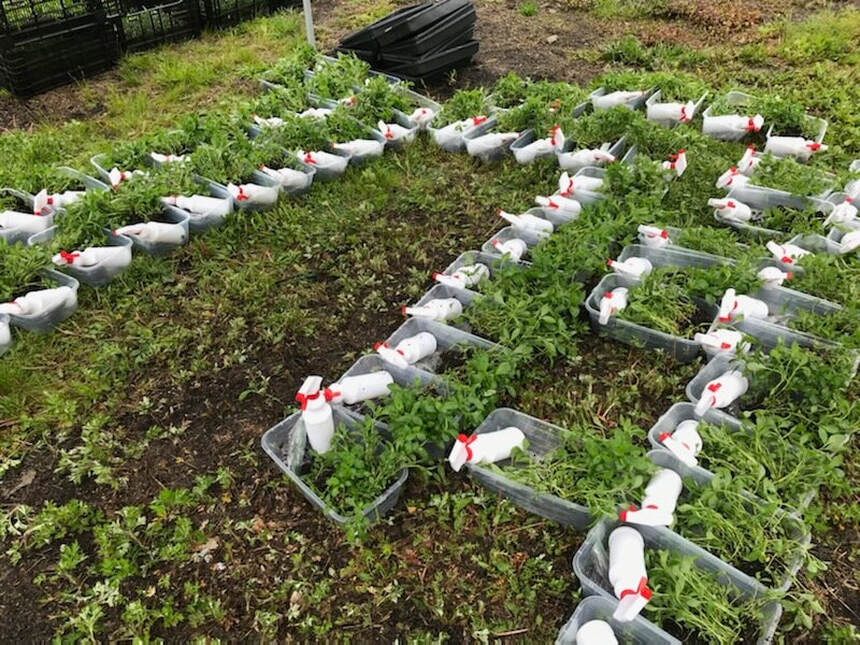|
After the success of last year’s volunteer effort to grow indigo plants to obtain their natural deep blue dye, Praxis Fiber Arts in the Waterloo Arts District of Collinwood has expanded its “Adopt Indigo” Program. “The program created a community project at a time when everyone felt so isolated,” said Jessica Pinsky, executive director of Praxis. “Though COVID is dwindling, we decided to do the project again, and we already have 200 volunteers lined up, which is our maximum.” Two of the volunteers concur that the program activated them at a time when nothing else was going on and gave them accountability for a community endeavor. “Especially during the beginning of the pandemic, it meant so much to be a part of something communal,” said Karen Beckwith, a visual artist and printmaker. “I felt an extra special responsibility for the indigo since we were growing it for Praxis, a place we love.” Her partner, Juliann Fausel, a weaver and former CMSD special education teacher, said, “It was a great excuse to get out of the house because the plants need to be tended, and it was a very enjoyable experience that gave us purpose.” The volunteer program’s roots Prior to the pandemic, roughly 50 people would gather to plant, tend and harvest the indigo plants in the Natural Dye Garden that Praxis used to dye fibers for weaving. Pandemic safety concerns forced them to reconfigure the project and enlist people willing to grow indigo plants at home. Last year, 75 people volunteered. Pinsky posted a weekly instructional YouTube video to guide volunteers through the growth and harvesting processes. Praxis works with the Cleveland Seed Bank that grows the indigo plant seeds in its greenhouse on the West Side for about six weeks. On the East Side they grow the seeds in the gardens of another community partner, the Hospice of the Western Reserve on the property of its headquarters in South Collinwood. Volunteers pick up their seedlings in May and grow them through the end of September. During that time, they should have at least three harvestings of the leaves that they collect and bring to Praxis. In exchange, they receive access to Praxis’ natural indigo dye vat and attend a workshop where they learn how to dye a scarf or a bandana. Focused on the Japanese indigo process Praxis employs a traditional Japanese method to grow, compost and convert the dried, composted leaves in 55-gallon fermentation vats into usable indigo dye. Praxis maintains all of the processing equipment in its garage. The amount of leaves required to perform the dying process is 400 pounds, so initially it took several years to collect that many leaves. “That’s why we’ve kept scaling up,” Pinsky said. “It doesn’t cost much more to have more people participate, but it helps increase the mass yield and allows us to get to the processing part faster.” Rowland Ricketts, a fiber artist who lived and studied indigo dying in Japan, is one of the leading experts in the Japanese indigo methods in the country. Pinsky met him early in her career when she attended a training course at his house to learn how to perform the entire process. She credits Ricketts with inspiring what became the Praxis Natural Dye project, and he serves as its mentor. “The indigo project at Praxis creates an opportunity for people to work together and learn through the growing, harvesting and processing of indigo using historical, sustainable methods to create a valuable and unique shared resource,” said Ricketts, associate dean of the Art and Design Department at Indiana University Bloomington. New program for schoolchildren This year, Praxis is adding a separate program for fifth-grade schoolchildren at the Hannah Gibbons STEM School in the Cleveland Metropolitan School District. Each student will receive a bag of seeds and all of the equipment they need in a kit and then follow an online workshop every week. The project will go from the first week of the academic year to the last week, and they will grow the plants at school or at home, then harvest and collect the leaves. During that time, Pinsky estimates they should have about eight leaf harvests. At the end of the year, they will use the indigo that they grew to dye a T-shirt or bandana that will be included in their kits. The indigo program is Praxis’ only fully funded grant project with roughly $20,000 from Cuyahoga Arts and Culture that is matched by the George Gund Foundation.
0 Comments
Leave a Reply. |
Archives
May 2021
Categories |
© PraxisFiberWorkshop. All rights reserved.
Praxis Fiber Workshop is a 501C3 non-profit and all contributions are tax-deductible within the provisions of the law




 RSS Feed
RSS Feed
